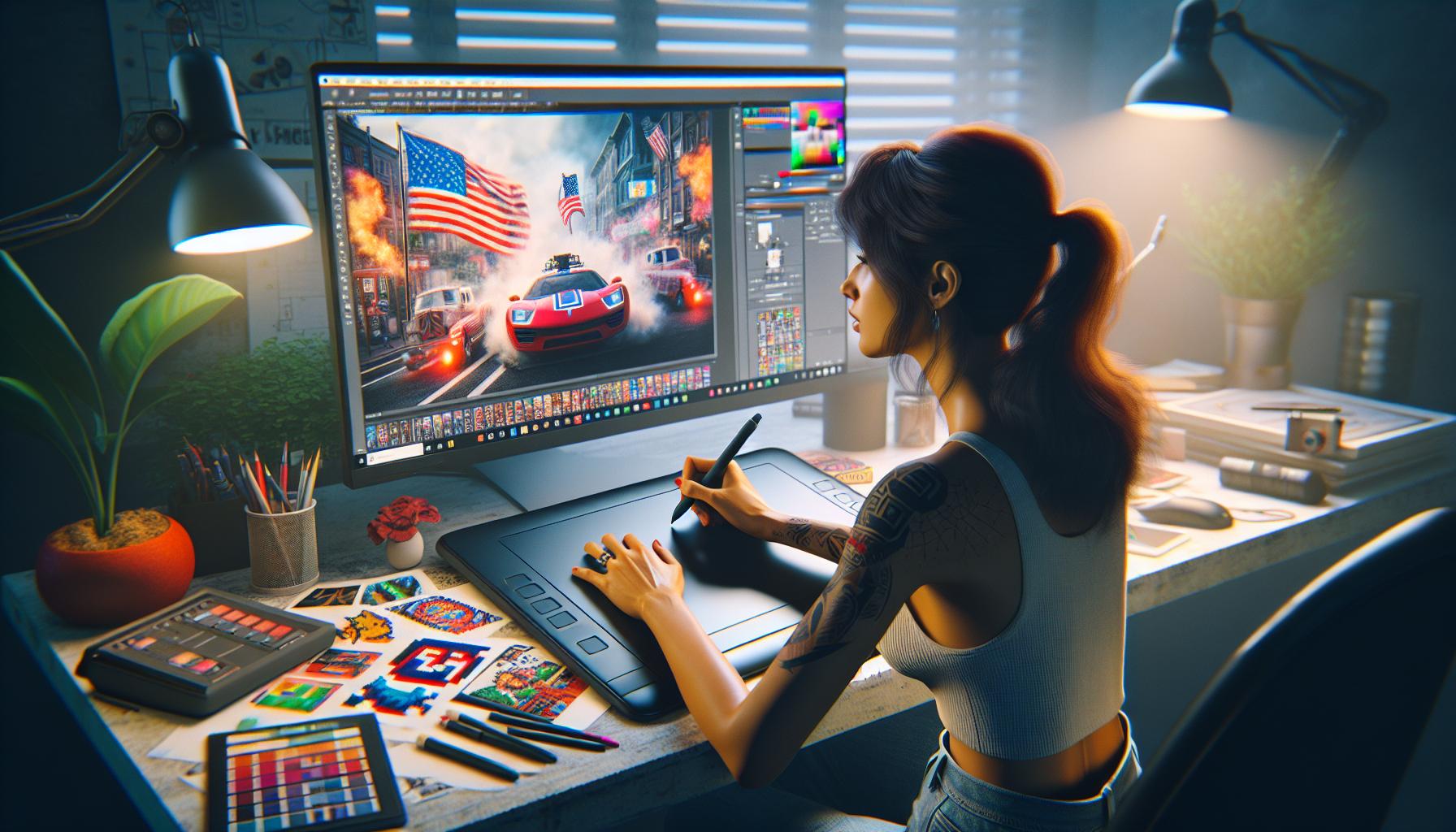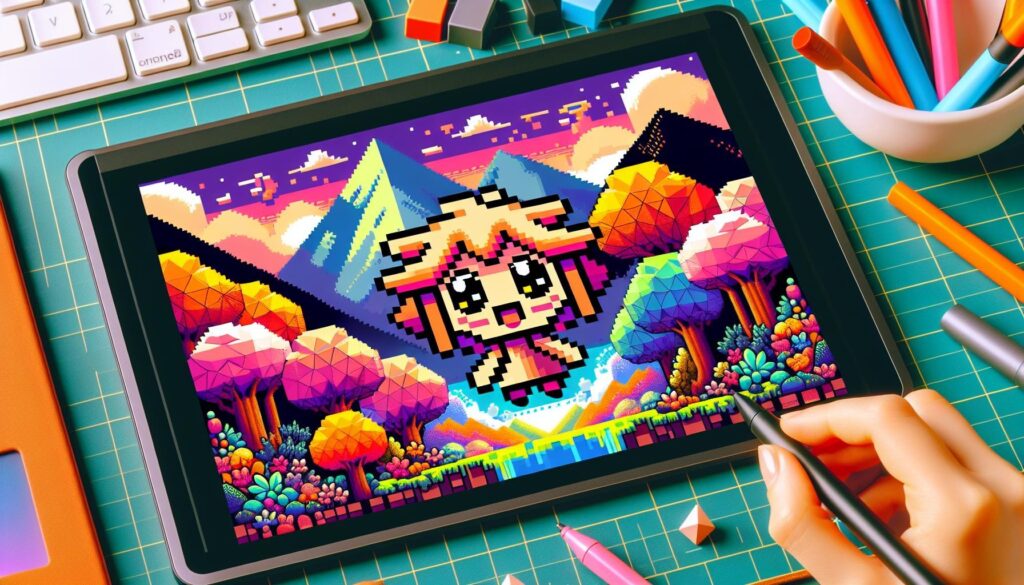Pixel art continues to captivate digital artists and gaming enthusiasts with its nostalgic charm and minimalist beauty. From retro video games to modern indie masterpieces, pixel art remains a beloved medium that combines simplicity with creative expression.
Creating pixel art doesn’t have to be complicated. With basic tools and simple techniques, anyone can transform individual pixels into charming characters, landscapes, and animations. Whether you’re a beginner looking to explore digital art or an experienced creator seeking a new challenge, pixel art offers an accessible entry point into the world of digital creativity.
Faciles:i7-lo5vkqzy= Dibujos De Pixeles
Pixel drawings represent digital artwork created by manipulating individual pixels on a grid. An image generator can assist in designing these works, with each pixel functioning as a building block, combining with others to form detailed images through precise color placement.
Pixel art consists of three primary components:
- Square pixels as base units
- Limited color palettes
- Grid-based placement systems
Digital artists create pixel drawings using specialized software tools that enable pixel-by-pixel editing. The process involves:
- Setting up a canvas with defined dimensions
- Placing colored pixels strategically
- Creating shapes through pixel clusters
- Adding details at the individual pixel level
Modern pixel drawings appear in various formats:
- Video game sprites
- Digital icons
- Web graphics
- Animated illustrations
The technical specifications of pixel art include:
| Aspect | Details |
|---|---|
| Resolution | 16×16 to 128×128 pixels |
| Color Depth | 8-bit to 32-bit |
| File Formats | PNG, GIF, BMP |
| Grid Size | 1-4 pixels per unit |
Advanced pixel drawings incorporate specialized techniques:
- Anti-aliasing for smooth edges
- Dithering for color transitions
- Color indexing for palette management
- Isometric perspective for 3D effects
- Clear silhouettes
- Consistent line thickness
- Strategic color clustering
- Defined focal points
Getting Started With Pixel Art

Creating pixel art starts with selecting appropriate tools and mastering fundamental techniques. The digital canvas transforms into a creative playground through proper setup and methodical pixel placement.
Essential Tools And Software
Digital artists create pixel art using specialized software designed for pixel-level editing. Aseprite stands out as an industry-standard tool with features like customizable brushes, animation capabilities and precise pixel control. Free alternatives include GraphicsGale, Paint.NET and Piskel, each offering core functionalities for pixel manipulation. Essential hardware includes a computer mouse or drawing tablet for accurate pixel placement.
| Popular Pixel Art Software | Key Features |
|---|---|
| Aseprite | Professional animation tools, custom brushes |
| GraphicsGale | Layer support, preview window |
| Paint.NET | Free, plugin support |
| Piskel | Browser-based, animation tools |
- Place corner pixels first to establish shape boundaries
- Build outlines using connected pixels in straight lines
- Fill shapes using the paint bucket tool
- Create smooth curves by stepping pixels diagonally
- Apply shading through adjacent pixel placement
Simple Pixel Art Designs For Beginners

Pixel art designs offer an accessible starting point for digital artists. These foundational projects help develop essential pixeling skills through structured practice.
Character Sprites
Basic character sprites start with a simple 32×32 pixel canvas grid. The design process begins with blocking out a stick figure silhouette using single pixels for the head, torso, arms, legs. Adding basic features like eyes, mouth, hair creates personality in 2-3 colors. Common sprite styles include chibi characters, robots, animals (cats, dogs, birds). The sprite comes to life through small details: a 2×2 pixel eye shine, 3×3 pixel hands, 4×4 pixel feet. Professional sprite artists recommend working in black and white first, then adding a limited 4-color palette to maintain visual clarity.
Basic Landscapes
Entry-level pixel landscapes focus on geometric shapes in nature. A standard 64×64 canvas accommodates simple scenes like rolling hills, forests, mountains. The composition uses blocks of 4×4 pixels for ground elements, 2×2 pixels for background details. Popular landscape elements include pine trees (triangular shapes), clouds (rounded clusters), grass (single pixel rows). Color choices remain minimal: 3 shades for the sky, 2-3 greens for vegetation, 2 browns for terrain. Atmospheric effects emerge from strategic pixel placement: scattered dots for stars, diagonal lines for rain, clustered squares for snow.
Step-By-Step Pixel Drawing Tutorial

Creating pixel art follows a structured approach that builds from simple elements to complex designs. Each stage requires attention to detail and precise pixel placement.
Creating Basic Shapes
Pixel art begins with fundamental geometric forms using single-pixel lines on a grid. Artists place pixels in straight lines to form squares, rectangles, triangles for basic character outlines or environmental elements. The process starts with a base silhouette using a single color, typically black pixels on a white background. Creating curves involves strategic pixel placement at 45-degree angles, forming diagonal lines that connect to create smooth transitions. Advanced shapes emerge by combining these basic elements:
- Draw horizontal lines pixel by pixel for flat surfaces
- Create vertical lines for structural elements
- Place diagonal pixels at consistent intervals
- Connect corners using single pixels
- Form circles through symmetrical pixel patterns
Adding Colors And Shading
Color application transforms basic shapes into dynamic pixel artwork. Artists start with a base color then add highlights and shadows to create depth. The process involves selecting 3-5 colors per element in the composition:
- Apply flat base colors within outlined shapes
- Add lighter pixels for highlights on upper edges
- Place darker pixels for shadows on lower edges
- Create mid-tones between light and dark areas
- Use dithering patterns for smooth color transitions
Color clustering techniques group similar shades together to maintain visual clarity. Lighting direction remains consistent throughout the piece with shadows falling at 45-degree angles. Contrast between light and dark areas establishes focal points and adds dimensional depth to flat shapes.
Tips To Improve Your Pixel Art
Establishing a consistent light source enhances pixel art depth through deliberate shadow placement. Professional pixel artists use color ramps of 3-5 shades to create realistic lighting effects.
Following these advanced techniques elevates pixel artwork:
- Create dithering patterns between colors using alternating pixels
- Apply selective anti-aliasing on curved edges
- Cluster similar colors together in distinct shapes
- Maintain single-pixel line consistency throughout
- Leave one-pixel spacing between distinct elements
Color management plays a crucial role in pixel art quality:
- Limit palettes to 16-32 colors maximum
- Group similar hues in designated zones
- Add accent colors sparingly for emphasis
- Use darker shades for outlines instead of pure black
- Implement color theory with complementary pairs
Advanced pixel placement techniques include:
- Jagged edges for organic shapes
- Smooth curves using pixel stepping
- Strategic noise for texture effects
- Balanced negative space distribution
- Pixel-perfect symmetry in characters
Reference grids optimize proportions:
| Grid Size | Best Used For |
|---|---|
| 16×16 | Icons |
| 32×32 | Characters |
| 64×64 | Portraits |
| 128×128 | Landscapes |
Analyzing professional pixel art reveals effective practices like maintaining clear silhouettes breaking complex shapes into smaller segments studying reference images for accurate proportions.
Popular Pixel Art Styles And Themes
Pixel art encompasses diverse artistic styles that shape modern digital aesthetics. Each style features unique characteristics catering to specific visual preferences.
Retro Gaming Style
- 8-bit sprites reminiscent of Nintendo Entertainment System games
- 16-bit detailed characters from Super Nintendo era graphics
- Limited color palettes with distinct outline techniques
- Arcade-inspired interface elements including score displays icons
Minimalist Design
- Single color silhouettes against contrasting backgrounds
- Two-tone compositions focusing on negative space
- Geometric patterns using basic pixel formations
- Simplified iconography for user interfaces applications
Fantasy Art
- Medieval themed characters including knights wizards dragons
- Magical effect animations with sparkle particle systems
- RPG style item icons featuring weapons armor potions
- Environmental tiles depicting castles dungeons forests
Isometric Designs
- Three dimensional architectural structures
- Diorama style game environments
- Technical machinery with rotating components
- Interior scenes with detailed furniture elements
Nature Elements
- Weather effects showing rain snow sunshine
- Landscape scenes featuring mountains lakes forests
- Plant life cycles demonstrating growth patterns
- Animal sprites in various animation states
- City skylines with varied building heights
- Street level scenes including cars pedestrians
- Cyberpunk environments featuring neon lighting
- Industrial zones with factories warehouses
The variety extends beyond these categories through combinations experimentation. Artists blend multiple styles creating unique visual signatures while maintaining pixel art fundamentals.
This section outlines primary styles without limiting creative exploration. Each theme serves as a foundation for developing distinctive pixel artwork.

